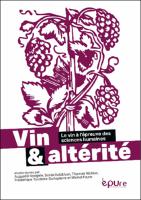Vin et altérité
Le vin à l'épreuve des sciences humaines
| dc.contributor.editor | Voegele, Augustin | |
| dc.contributor.editor | Nicklas, Thomas | |
| dc.contributor.editor | Toudoire-Surlapierre, Frédérique | |
| dc.contributor.editor | Faure, Michel | |
| dc.contributor.editor | Goldblum, Sonia | |
| dc.date.accessioned | 2022-02-23T12:51:40Z | |
| dc.date.available | 2022-02-23T12:51:40Z | |
| dc.date.issued | 2020 | |
| dc.identifier | ONIX_20220223_9782374961057_3 | |
| dc.identifier | ONIX_20220223_9782374961057_3 | |
| dc.identifier | OCN: 1308749501 | |
| dc.identifier.uri | https://library.oapen.org/handle/20.500.12657/53134 | |
| dc.language | French | |
| dc.subject.classification | thema EDItEUR::J Society and Social Sciences::JB Society and culture: general::JBC Cultural and media studies::JBCC Cultural studies::JBCC4 Cultural studies: food and society | en_US |
| dc.subject.classification | thema EDItEUR::W Lifestyle, Hobbies and Leisure::WB Cookery / food and drink / food writing::WBX Food and drink: beverages::WBXD Food and drink: alcoholic beverages::WBXD1 Wines | en_US |
| dc.subject.other | Wine history | |
| dc.subject.other | Wine in literature | |
| dc.subject.other | Wine: social aspect | |
| dc.title | Vin et altérité | |
| dc.title.alternative | Le vin à l'épreuve des sciences humaines | |
| dc.type | book | |
| oapen.abstract.otherlanguage | As a reflection of a terroir and a landscape, as an emblem of a region, a nation or a civilisation, wine also facilitates a connection between cultural dimensions that we are used to discriminating in our everyday representations (human/divine, human/animal, noble/common, beautiful/monstruous, natural/artificial). It is thus a vector of alterity, an invitation to go towards the other, to modify or alter one's vision of the world, to cross not only regional and national borders, but also the threshold between the profane and the sacred. It was therefore essential to combine the thoughts of wine professionals with those of researchers from many areas of the human sciences, from history to economics, linguistics, semiotics, communication sciences and literary criticism. Reflet d'un terroir et d’un paysage, emblème d’une région, d’une nation ou d’une civilisation, le vin facilite aussi le rapprochement entre des dimensions culturelles que nous sommes habitués à distinguer dans nos représentations ordinaires (humain/divin, humain/animal, noble/vulgaire, beau/monstrueux, naturel/artificiel). Il est ainsi vecteur d’altérité, il invite à aller vers l’autre, à modifier ou altérer sa vision du monde, à franchir non seulement les frontières régionales et nationales, mais également le seuil séparant le profane du sacré. Il était donc indispensable d’associer les réflexions de professionnels spécialistes du vin à celles de chercheurs issus de nombreux secteurs des sciences humaines, de l’histoire à l’économie en passant par la linguistique, la sémiotique, les sciences de l’information et de la communication ou encore la critique littéraire. | |
| oapen.identifier.doi | 10.34929/rskf-8724 | |
| oapen.relation.isPublishedBy | 9a5b0990-15ee-4dd2-a1b6-c01b4a09951e | |
| oapen.relation.isbn | 9782374961057 | |
| oapen.relation.isbn | 9782374960791 | |
| oapen.pages | 250 | |
| oapen.place.publication | Reims |

